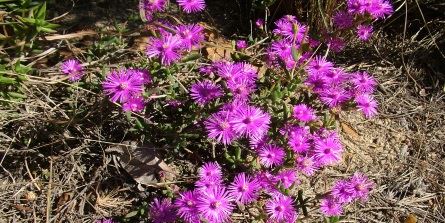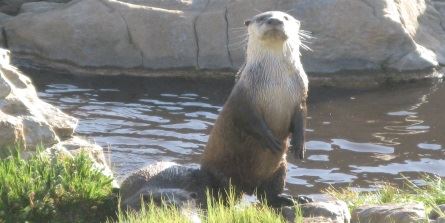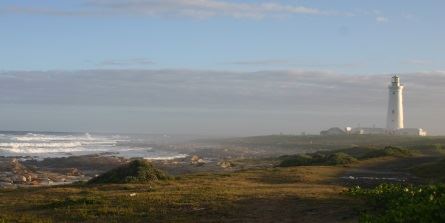While small in size, the word ‘eco’ holds great significance in the Southern African tourism industry as more and more environmentally conscious travellers flock to South Africa in search of natural adventure, wildlife, culture and history. The Cape St Francis Resort is a champion when it comes to promoting the spectacular natural highlights that the oft-underrated Eastern Cape holds, as well as establishing the Kouga region as a major player in eco-friendly travel.
The south-eastern tip of the African continent forms part of the Agulhas Plain, where the San and Khoi people once found refuge against the Ice Age. While many others perished, these two cultural groups thrived on the magnificent abundance of plant and animal life in the region. Today the south-eastern coastline is rich in relics dating back over a million years, and the prehistoric remains of shellfish and bulbs piled in midden shells that support the theory that mankind as we know it originated here.
The area also falls into the Cape Floral Kingdom, a Unesco World Heritage Site described by the organisation as being of ‘outstanding universal significance to humanity’ and ‘one of the richest areas for plant diversity in the world’. Often referred to as the ‘hottest hot-spot’ of plant diversity on the planet, the area is home to almost 20% of Africa’s flora and its outstanding diversity, density and endemism is among the highest worldwide.

Fynbos-covered Cape St Francis falls into and epitomises this globally important centre of terrestrial biodiversity and rich cultural history where white sand dunes roll into indigenous bushland, providing food and shelter for a host of smaller animal species and birds, while midden sites and historic shipwrecks litter the coastline at regular intervals.
The Cape St Francis Resort and Conference Centre lies in the middle of the village and offers its visitors a unique and rewarding perspective of this pristine, historic and relatively untouched region. Much of the village forms part of protected nature reserves, with no fewer than five in the area, and there are a myriad of fabulous walks and hikes to choose from, taking you from colourful coastal vegetation to rocky outcrops and along quiet stretches of beach. In fact there are so many options when it comes to outdoor choices that the Cape St Francis Resort has put together a comprehensive list of hiking and walking trails in the area to let travellers make an informed choice.
Besides the obvious advantage of having pockets of natural paradise all around, these nature reserves are all easily reached from the Cape St Francis Resort and offer an authentic eco experience without having a touristy or commercial feel. The reserves are open to everyone and have no entrance fees, so visitors can enjoy them at their leisure and often without bumping into anyone else at all.
Here is the Cape St Francis Resort’s list of the ‘Natural Five ‘.
Cape St Francis Nature Reserve
The largest of the five, the Cape St Francis Nature Reserve is situated between Cape St Francis and St Francis Bay, covering 120 hectares of endemic Milkwood and Candlewood thickets, beautiful sandy spans of beach, a rustic rocky point and rolling sand dunes with spectacular views over St Francis Bay. There are three hiking trails to choose from, varying in length and all taking visitors through fragrant coastal dune fynbos and coastal thicket. Look out for the Cape clawless otter, Bottlenose dolphin, rare Black oystercatcher and perhaps even an endangered African penguin in and around the ocean while small mammal species such as bushbuck, duiker, mongoose and porcupine may be spotted in the bush. Lose yourself in the splendour of Cape St Francis on this peaceful and scenic walk.
Seal Point Nature Reserve

Housing the historic Cape St Francis Lighthouse, the Seal Point Nature Reserve offers wild, rugged ocean beauty at its best with sparkling rock pools filled with marine life and wonderful refreshing walks where Southern Right whales may be spotted during birthing season. Here you will find the SANCOB-run penguin and seabird rehabilitation centre where donations can be made in support of the endangered and endemic African penguin. You can also walk to Shark Point, passing by Shelly Beach, a good place to spot Black oystercatchers, and though rich midden sites before reaching the point where the remnants of shipwrecks still lie.

Seal Bay Nature Reserve
Seal Bay Nature Reserve, or simply ‘Seals’ as it is known to locals, is arguably one of the most beautiful and pristine recreational beaches in South Africa. Its long stretches of sand lend themselves to meandering strolls while the main beach area is safe for swimming. Its waves are a favourite among surfers all over the world and at low tide the rock pools are a great place for discovering marine wonders.
St Francis Field Nature Reserve
This 54-hectare reserve forms part of the St Francis Field Country Estate, an exclusive lifestyle destination and air park. The estate offers the unique blend of an environmental sanctuary, aviation facilities and residential homes and has been careful not to let development encroach on to the splendid natural landscape that surrounds it. Sherwood Forest consists of hundreds-of-years-old protected Milkwood, Candlewood and other indigenous trees and offers an enchanting walking trail that twitchers will love. Knysna warblers, Fiery-necked nightjars and Jackal buzzards are among some of the impressive bird species found here, while bushbuck, wild pig and honey badgers rustle around in the fynbos. The estate is also home to a vineyard and olive orchard.
Irma Booysens Nature Reserve
This small reserve can be accessed through various points in the village and is ideal for an easy and enjoyable walk. The trees are marked for easy identification and you will find benches every so often along the well-marked paths, where walkers can take a breather and absorb the sights and sounds of nature and birdlife around them. The dune fynbos that covers most of the reserve is a delicate and unique species of flora, particularly pretty to see in the spring when riots of colourful small flowers adorn the bush and brighten up the landscape. Many insects, reptiles and birds are regular inhabitants of this scenic little reserve.























